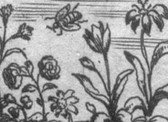
By
Deanna Smid
November 2022
Print Version
What you need to know
England in the 17th century saw a particular swarming of bee metaphors, perhaps because of an increase in beekeeping treatises that were published by actual beekeepers. One poet, Hester Pulter, wrote a fascinating “emblem” comparing a bee and a snail, both trapped in a tulip overnight. The poem, I argue, emphasizes the cultural significance of bees and highlights the necessity of female community.
Why this research is important
My students can tell you that I warn them never to start an essay with “since the dawn of time.” Since the dawn of time, however, honeybees have been a buzzword for good governance, social cooperation, chastity and prudence, and even artistic talent. When Plato was an infant, for instance, bees reportedly landed on his lips, denoting that his words would be “honeyed.” In William Shakespeare’s Henry V, the Archbishop of Canterbury uses an extended metaphor of bees and beehives (you could say he drones on) to flatter King Henry and to encourage him to invade France. Napoleon chose the bee as the symbol of his coronation, and Brigham Young used the bee as an emblem of his settlement in Utah.
Much more recently, “Save the bees” has become a well-known mantra ever since Colony Collapse Disorder was first reported in 2006. Economic reports place the value of insect pollination in the billions of dollars, so losing bees would be an ecological and economic disaster. But what about the emotional and symbolic consequences of disappearing bees?
Many of the foundational symbols of our society—how we think about ourselves, our community, our political structures, our interpersonal relationships—are based on bees and beehives. Combing through mythology, religion, and political history reveals bees at every turn. So, what happens to the stories we tell about ourselves when bees are in decline, or are gone altogether? The loss will be far greater than an economic or ecological one.
How the research was conducted
This research is a contribution to “The Pulter Project,” a website and database that invites scholars to edit and discuss Pulter’s poems and issues pertaining to 17th-century poetry. Each new “Amplified Edition” of one of the poems is rigorously peer-reviewed, and the extensive notation on each poem offers readers multiple perspectives on the same work.
What the researcher found
Hester Pulter’s writings are an incredibly rich insight into the life and imagination of a woman living during the English Civil War. Emblem 53: “The Snail, the Tulip, and the Bee,” begins with the rising of the sun over a beautiful, idyllic garden. A bee flies out of the hive and begins foraging amongst the flowers. So far, all is as it should be. At the close of the day, when the bee should return to the hive, she notices a tulip and diverts her flight, even though she is already laden with pollen. While in the tulip, the petals close at night, and the bee finds herself trapped inside the flower together with a snail that had also been exploring the plant. The snail tries to rest, but the bee struggles furiously against her prison. In the morning when the tulip’s petals open again, the snail slides out, but the bee is dead of exhaustion. The last line of the poem warns readers to “think on the snail, the tulip, and the bee.”
The poem is remarkable because of its negative depiction of the bee. In countless other examples from the 17th century and earlier, bees are positive exemplars, models that people should try to emulate. Pulter’s bee, however, is doomed because of its never-ending toil. My edition of the poem argues that the bee dies not only because it refuses to rest but, in particular, because it refuses the community of others. The bee’s error is not returning home to the safety of the hive. On her own, the bee (like any honeybee) is vulnerable, and a solitary honeybee will not live long. Then, Pulter’s bee has another chance for community inside the tulip. The poem genders both the tulip and the snail female, and while the tulip is no substitute for the safety of the hive, the bee could survive if she followed the restful example of the two females with her. Instead, she struggles alone, and dies alone.
The poem, therefore, emphasizes the power and necessity of community, and female community at that. Being alone, being separated from the support of other women, seemed a terrible thought for Pulter, and her emblem of the tulip, the snail, and the bee goes so far as to equate solitude with death.
How this research can be used
The research highlights the cultural and symbolic imperative of bees. It also expands our understanding of the lives of 17th-century English women, and it calls attention to the process of editing poetry in a manuscript.
About the Researcher
Keywords
- bees
- seventeenth-century poetry
Publications Based on the Research
Smid, D. (Ed.). (2022). “The Snail, the Tulip, and the Bee (Emblem 53)” by Hester Pulter. (Poem 118, Amplified Edition). In L. Knight, & W. Wall (Eds.), The Pulter Project: Poet in the Making. http://pulterproject.northwestern.edu
Editor: Christiane Ramsey
Read more BU Research
Research at Brandon University follows comprehensive policies designed to safeguard ethics, to ensure academic integrity, to protect human and animal welfare and to prevent conflicts of interest.

